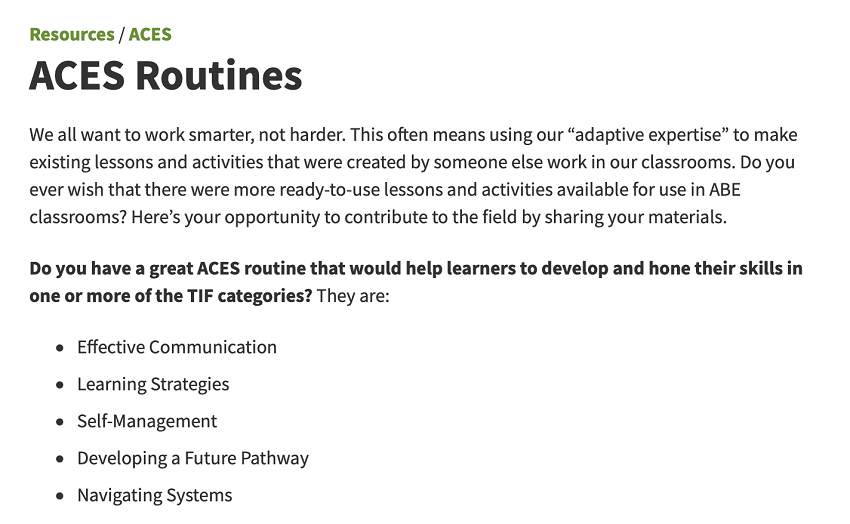- MN ABE Connect
- Archive
- Throwback Thursdays and Other Life-Changing Routines
 January 30, 2023
January 30, 2023
Throwback Thursdays and Other Life-Changing Routines
Stephanie Sommers, ACES CoordinatorHere’s a riddle for you. What can make bedtime easier, skin dewier, and bodies fitter? Here’s a hint. It can also make your classroom easier to manage, your students more relaxed, and your lesson planning simpler. Do you know what it is yet? If you guessed routines, you are correct.
A routine is simply a series of steps that you complete on a regular basis. Routines are powerful instructional tools because they are repeated, and, therefore, made predictable. Students who have anxiety about learning or have experienced trauma can benefit greatly from routines because the routines allow them to anticipate what is going to happen next, which lowers stress and makes it easier to learn. But routines have other benefits as well. Keep reading to explore the power of one of our favorite TIFing methods – the routine.
Pro tip: The TIF (Transitions Integration Framework) is one of three documents that comprise the content standards for Minnesota Adult Education.
There are many different types of routines that can be used in a classroom. Here are a few examples of how a clearly defined routine can guide students:
- Communicating with the teacher outside of class
- Accessing work after an absence or for independent study
- Participating respectfully in class discussions
- Entering class late or exiting early
- Organizing class materials
- Taking notes
The examples from the list above are routines to help with classroom management and to boost learner independence. There are also a host of instructional routines that teachers can implement that help students to master content. The Adult Numeracy Network, for example, maintains a wonderful list of instructional routines related to teaching math (https://adultnumeracynetwork.org/Instructional-Routines).
Many of these routines, like “Notice and Wonder,” can easily be adapted to other content areas. I am also very proud to promote a new collection of ACES Routines that is being curated as part of the TIF 2.0 project. These routines are available in the ACES resource library on the ATLAS website.
Routines like these are effective because they allow students to focus on what they’re learning, not how to go about learning it. From a cognitive science lens, here’s what that means:
Routines free up students’ working memory and reduce cognitive load so that instead of dedicating all of their focus to day-to-day tasks, they can focus on learning (Leinhardt, Weidman, & Hammond, 1987).
In other words, if students clearly understand what to do when they miss class, for example, they don’t have to focus their time and thought energy on figuring that process out. Instead, they can complete the steps they have been taught and get back to learning more quickly and easily.
 But routines do not just make things easier for students. Teachers also benefit from the structure that they bring. Implementing routines in your classroom can provide some of the same benefits as having a weekly meal rotation: it gives you one less thing to think about. Just like Thursdays might mean favorite Throwback Thursday meals at home, it might mean reflection journals or analyzing GED questions for students in class.
But routines do not just make things easier for students. Teachers also benefit from the structure that they bring. Implementing routines in your classroom can provide some of the same benefits as having a weekly meal rotation: it gives you one less thing to think about. Just like Thursdays might mean favorite Throwback Thursday meals at home, it might mean reflection journals or analyzing GED questions for students in class.
Like most things that yield big rewards, establishing routines takes time and effort. You must be willing to repeat and reteach the routine on a regular basis. You also must be comfortable with the idea that your students might not excel at a routine the first time that you try it. Like a garden, routines take time to establish, but if you commit to them, they will produce beautiful results.
For more ideas about using instructional routines in your classes, please join us for the first ACES “TIFfy Tuesdays” Webinar on Tuesday, February 28 from 1:30-3:00pm CST. We will:
- Explore using routines to support the development of ACES/TIF skills
- Learn about some of the new ACES routines that were developed as part of the TIF 2.0 initiative
- Hear from a teacher who is successfully implementing these routines in her classroom
- Hear from Andrea Echelberger, who will talk about how routines can be an integral part of trauma-informed teaching
Newsletter Signup
Get MN ABE Connect—the official source for ABE events, activities, and resources!
Sign UpArticle Categories
- ABE Foundations/Staff Onboarding
- ACES/Transitions
- Adult Career Pathways
- Assessment
- CCR Standards
- Citizenship
- COVID-19
- Cultural Competency
- Digital Literacy/Northstar
- Disabilities
- Distance Learning/Education
- ELA
- Equity/Inclusion
- ESL
- HSE/Adult Diploma
- Listening
- Math/Numeracy
- Mental Health
- Minnesota ABE
- One-Room Schoolhouse/Multilevel
- Professional Development
- Program Management
- Reading
- Remote Instruction
- Science
- Social Studies
- Speaking/Conversation
- Support Services
- Teaching Strategies
- Technology
- Uncategorized
- Volunteers/Tutors
- Writing

